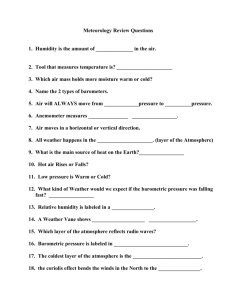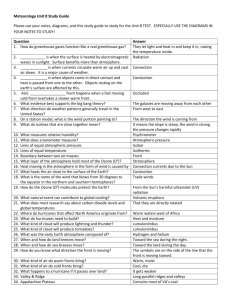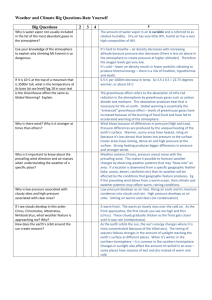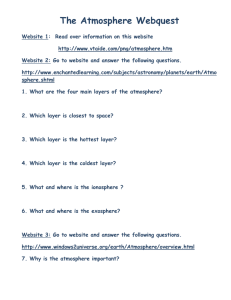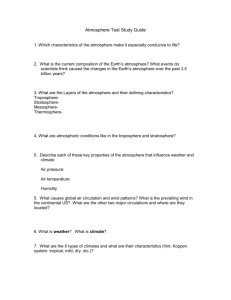TE 401: Lesson and Unit Plan Template
advertisement
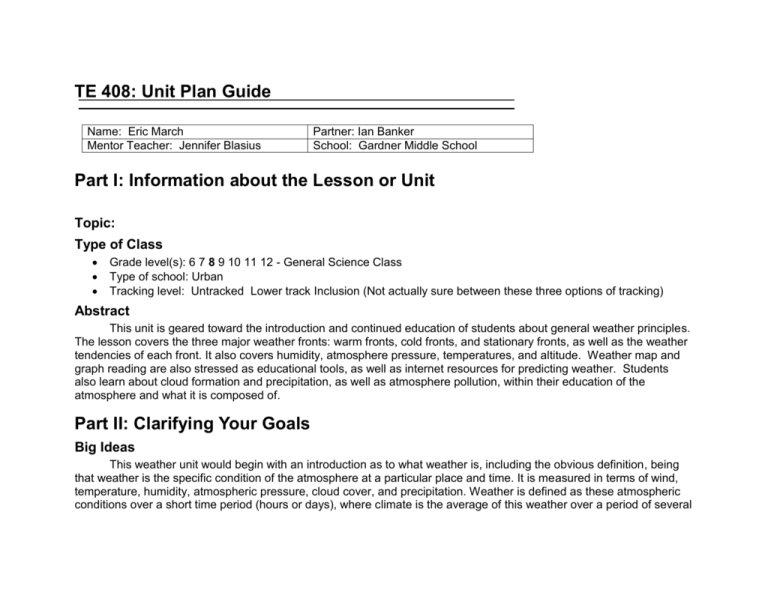
TE 408: Unit Plan Guide Name: Eric March Mentor Teacher: Jennifer Blasius Partner: Ian Banker School: Gardner Middle School Part I: Information about the Lesson or Unit Topic: Type of Class Grade level(s): 6 7 8 9 10 11 12 - General Science Class Type of school: Urban Tracking level: Untracked Lower track Inclusion (Not actually sure between these three options of tracking) Abstract This unit is geared toward the introduction and continued education of students about general weather principles. The lesson covers the three major weather fronts: warm fronts, cold fronts, and stationary fronts, as well as the weather tendencies of each front. It also covers humidity, atmosphere pressure, temperatures, and altitude. Weather map and graph reading are also stressed as educational tools, as well as internet resources for predicting weather. Students also learn about cloud formation and precipitation, as well as atmosphere pollution, within their education of the atmosphere and what it is composed of. Part II: Clarifying Your Goals Big Ideas This weather unit would begin with an introduction as to what weather is, including the obvious definition, being that weather is the specific condition of the atmosphere at a particular place and time. It is measured in terms of wind, temperature, humidity, atmospheric pressure, cloud cover, and precipitation. Weather is defined as these atmospheric conditions over a short time period (hours or days), where climate is the average of this weather over a period of several years or more. The atmospheric conditions are one of the major causes of the weather, including the layering of the atmosphere with mixing between them and subsequent air flow patterns. Within atmospheric conditions, 3 major fronts occur: warm fronts, cold fronts, and stationary fronts. Each of these fronts is characterized by certain weather conditions: Warm fronts are when warm air masses replace cold air in a region. Cold fronts occur when cold air replaces warm air in a region. Stationary fronts are said to occur when either a warm front or a cold front has not moved in to replace the other over a time period of several hours. It is important to note that the atmosphere is not the same the farther away from Earth it gets. Weather only occurs in the lowest part of the atmosphere, which is also where most of the air particles are located. As the distance from the Earth gets larger, fewer air particles are found. The make-up or composition of the atmosphere is not constant, either. The air is made up of air molecules, as well as oxygen, water, nitrogen, and ozone. Additionally, the air contains pollution particles that can have negative effects on people that breathe them in. Finally, clouds and water play an important part in the atmosphere. Water falls from the clouds as precipitation in the form of rain or sleet or snow, and drains off the land into the lakes and oceans. This water is then evaporated by the sun back into the atmosphere where it can form clouds again, repeating the cycle. Experiences, Patterns, and Explanations Observations or experiences (examples, phenomena, data) Summer is hot Winter is cold Spring/Fall are warm/cool Snow falls in winter Wind speed can change Exhaust from car is dirty = polluted air Air feels sticky in the summer Air becomes thinner as the elevation increases Dark clouds bring rain / snow Patterns (laws, generalizations, graphs, tables, categories) Cloud covering sun – provides shade and a little cooler Cloud not covering sun – no shade and warm up Sweat more in summer than winter Snow is dry, rain is wet The air cleans up after it gets dirty Explanations (models, theories) Pollution causes smog / fog Dark clouds hold rain Wind usually increases with the rain Snow is just frozen rain Wind cleans up pollution in the air Cloudy days are cooler than clear days Winter feels dry S’s understand air is not a single uniform thing Air feels sticky in the summer Air becomes thinner (less dense) as the elevation increases Snows in the winter, rains every other season Factories, cars, and other forms of industry cause air pollution Sweat more in the summer Air is more humid in the summer Large water bodies buffer the extreme temperatures Earth’s atmosphere has multiple layers Earth’s atmosphere dilutes pollution, but only to a certain point Air composition – 78%N, 21%O, 2%CO2, other trace gases, dust particles, ozone Sweating less effective due to high humidity Hot air can hold more moisture Pollution causes yellow smog, but does not cause morning fog Earth’s atmosphere has 5 layers, with the troposphere being the one we are in Lakes and Oceans keep the land cooler in the summer Application: Model-based Reasoning – using models/theories to explain experiences Inquiry: Finding and Explaining Patterns in Experience Objectives for Student Learning Michigan Objectives Type Michigan High School (current) 1. E4.p2A Describe the composition and layers of the atmosphere. Content (Using) (prerequisite) 2. E4.p2B Describe the difference between weather and climate. Content (Using) (prerequisite) 3. E4.p2C Explain the differences between fog and dew formation and Content (Using) cloud formation. (prerequisite) 4. E4.p2D Describe relative humidity in terms of the moisture content Content (Using) of the air and the moisture capacity of the air and how these depend on the temperature. (prerequisite) 5. E4.p2E Describe conditions associated with frontal boundaries Content (Using) (cold, warm, stationary, and occluded). (prerequisite) 6. E4.p2F Describe the characteristics and movement across North Content (Using) America of the major air masses and the jet stream. (prerequisite) 7. E4.p2G Interpret a weather map and describe present weather Content (Using) conditions and predict changes in weather over 24 hours. (prerequisite) 8. E4.p2H Explain the primary causes of seasons. (prerequisite) 9. E4.p2I Identify major global wind belts (trade winds, prevailing westerlies, and polar easterlies) and that their vertical components control the global distribution of rainforests and deserts. (prerequisite) Content (Using) Content (Using) Michigan Middle School (2000 version) 1. Explain patterns of changing weather and how they are measured. Key concepts: Weather patterns—cold front, warm front, stationary front, air mass, humidity. Tools: Thermometer, rain gauge, wind direction indicator, anemometer, weather maps, satellite weather images. Real-world contexts: Sudden temperature and cloud formation changes; records, charts, and graphs of weather changes over periods of days; lake effect snow. 2. Describe the composition and characteristics of the atmosphere. Key concepts: Composition—air, molecules, gas, water vapor, dust particles, ozone. Characteristics—air pressure and temperature changes with altitude, humidity. Real-world contexts: Examples of characteristics of the atmosphere, including pressurized cabins inairplanes, demonstrations of air pressure; examples of air-borne particulates, such as smoke, dust, pollen, bacteria; effects of humidity, such as condensation, dew on surfaces, comfort level of humans. 3. Explain the behavior of water in the atmosphere. Key concepts: Water cycle—evaporation, water vapor, warm air rises, cooling, condensation, clouds. Precipitation—rain, snow, hail, sleet, freezing rain. Relative humidity, dew point, fog. See PCM-IV.2 m.1 (changes of state), EH-V.2 m.2 (water on the earth’s surface). Real-world contexts: Aspects of the water cycle in weather, including clouds, fog, precipitation, evaporating puddles, flooding, droughts. 4. Describe health effects of polluted air. Key concepts: Effects—breathing difficulties, irritated eyes. Sources—car exhaust, industrial emissions. Acid rain. Real-world contexts: Locations and times where air quality is poor; local sources of potential air pollution; ozone warnings. Synthesized Unit Objectives 1. Students will be able to gather data to accurately predict such weather features as temperature, humidity, cloud cover, dewpoint, wind direction / speed, etc. and / or they should be able to read this information from a weather map. 2. Students will be able to explain the weather differences between different locations based off of altitude, latitude, proximity to water, time of day, and season of the year. 3. Students will be able to describe the weather conditions and tendencies present at each of the three weather fronts, warm, cold and stationary. Content (Using) 4. Students will be able to describe the effects of air pollution both to humans and the effects that it has on the Earth’s atmosphere Content (Using) Content (Using) Content (Using) Part III: Assessment and Activities ASSESSMENT You become the teacher: Students will be split up into 6 different groups. Each group will be assigned to 1 of the 3 fronts (warm, cold, stationary), with 2 groups covering each front. Each group will be responsible for becoming an “expert” on the particular front and explaining it to the rest of the class. As doing such, they will be creating a poster, depicting what the front looks like via a side diagram, the signals for the front on a weather map, the characteristics of the particular weather front (rainy, windy, sunny, etc…). The following day, each group presented their poster and their findings on the weather front assigned to them to the rest of the class, acting as a teacher. Student-Generated Questions Have students, at a time close to the end of the unit, create three questions that they think should be on the test regarding weather. This allows us to see where the students stand with the information, and encourages the students to create good questions because they know that if they write a “good” question that their question might be selected to be on the test and they would already know the answer. ACTIVITIES Models/Pictures/Diagrams – Students will work in pairs and be given a figure of an altitude graph from 0-10,000m, and a marker. They are told that they are allowed to make 50 dots on this piece of paper, and that the objective of these 50 dots were to show how the air molecules would be spread out through the atmosphere. Are they evenly spread out? Are they all high, or are they all really low? Then we compare and discuss with a similar picture drawn on the board, explaining how atmosphere pressure is related to elevation and how the spacing of molecules in the atmosphere changes with elevation. Make a weather station Students will make a weather station in class, with the each pair of students making a barometer, rain gauge, and a psycrometer. Students will then, between the two of them, use the instruments to collect data over a one month period. This data will be analyzed by students, along with the effect on the weather instruments by the combination of the atmosphere and the weather will be discussed as a class. Cloud in a bottle Students will first crush up half a piece of chalk into a fine dust. This should be done between a folded piece of paper to prevent the mess. They will next take a jar and fill it with hot water (~120F), screw the cap on, and let the jar stand for 3 minutes to warm. Next, dump out 2/3 of the water, and place another cap on it. This cap will be larger, and have holes punched in it (5, made with a nail) to let air transfer. Place 2 ice cubes on top of the jar cap, and let it stand for 3 minutes. Now, remove the ice cubes and the cap, and sprinkle some finely ground chalk in the jar and immediately screw the original jar cap on. Within a few minutes, clouds should form in the jar, with the chalk particles acting as condensation nuclei for the clouds to condense upon. This could be extended to show that with too much pollution in the air, an otherwise non-rainy area might become rainy because the rain droplets would now have something to form on (the pollution particles in the air). Data Collection Students will be given the daily newspaper, or to ensure that the experiment works as planned, a pre-planned set of high temperatures for a period of two – three weeks. After this initial period of data collection where the students will write the high temperature on a chart, they students will then draw a bar graph either using graph paper or a graphing program on the computer. The key feature of this exercise is that there needs to be a significant drop in temperature that the students can see on the bar graph. This allows the teacher to explain that a cold front moved through the area. After the initial bar graph is completed, the teacher can have a brainstorming session with the students about things such as why the temperature dropped. The teacher can use inquiry and allow the students to formulate hypothesis, and then help them figure out which one of them is most correct. Synthesized Unit Objectives Summative Assessment Major Activity Students will be able to gather data to accurately predict such weather features as temperature, humidity, cloud cover, dewpoint, wind direction / speed, etc. and / or they should be able to read this information from a weather map. Students will work in pairs and be given a figure of an altitude graph from 010,000m, and a marker. They are told that they are allowed to make 50 dots on this piece of paper, and that the objective of these 50 dots were to show how the air molecules would be spread out through the atmosphere. Are they evenly spread out? Are they all high, or are they all really low? Then we compare and discuss with a similar picture drawn on the board, explaining how atmosphere Students will work in pairs and be given a figure of an altitude graph from 0-10,000m, and a marker. They are told that they are allowed to make 50 dots on this piece of paper, and that the objective of these 50 dots were to show how the air molecules would be spread out through the atmosphere. Are they evenly spread out? Are they all high, or are they all really low? Then we compare and discuss with a similar picture drawn on the board, pressure is related to elevation and how the spacing of molecules in the atmosphere changes with elevation. explaining how atmosphere pressure is related to elevation and how the spacing of molecules in the atmosphere changes with elevation. Students will be able to explain the weather differences between different locations based off of altitude, latitude, proximity to water, time of day, and season of the year. Students will make a weather station in class, with the each pair of students making a barometer, rain gauge, and a psycrometer. Students will then, between the two of them, use the instruments to collect data over a one month period. This data will be analyzed by students, along with the effect on the weather instruments by the combination of the atmosphere and the weather will be discussed as a class. student generated questions might be helpful to gauge understanding as well. Students will make a weather station in class, with the each pair of students making a barometer, rain gauge, and a psycrometer. Students will then, between the two of them, use the instruments to collect data over a one month period. This data will be analyzed by students, along with the effect on the weather instruments by the combination of the atmosphere and the weather will be discussed as a class. Students will be able to describe the weather conditions and tendencies present at each of the three weather fronts, warm, cold and stationary. Students will be split up into 6 different groups. Each group will be assigned to 1 of the 3 fronts (warm, cold, stationary), with 2 groups covering each front. Each group will be responsible for becoming an “expert” on the particular front and explaining it to the rest of the class. As doing such, they will be creating a poster, depicting what the front looks like via a side diagram, the signals for the front on a weather map, the characteristics of the particular weather front (rainy, windy, sunny, etc…). The following day, each group presented their poster and their findings on the weather front assigned to them to the rest of the class, acting as a teacher. They will be graded on their poster and how accurately the represent the information. Students will be given the daily newspaper, or to ensure that the experiment works as planned, a pre-planned set of high temperatures for a period of two – three weeks. After this initial period of data collection where the students will write the high temperature on a chart, they students will then draw a bar graph either using graph paper or a graphing program on the computer. The key feature of this exercise is that there needs to be a significant drop in temperature that the students can see on the bar graph. This allows the teacher to explain that a cold front moved through the area. After the initial bar graph is completed, the teacher can have a brainstorming session with the students about things such as why the temperature dropped. The teacher can use inquiry and allow the students to formulate hypothesis, and then help them figure out which one of them is most correct. 4. Students will be able to describe the effects of air pollution both to humans and the effects that it has on the Earth’s atmosphere Unit tests / quizzes to gauge their understanding of pollution and the effects that it can have on the Earth and the environment. Test will have to focus on the fact that the environment can dilute pollution, but only up to a saturation point, at which point the pollution tends to build up over cities, in valleys, etc. and starts to cause negative consequences for everyone involved. Students will first crush up half a piece of chalk into a fine dust. This should be done between a folded piece of paper to prevent the mess. They will next take a jar and fill it with hot water (~120F), screw the cap on, and let the jar stand for 3 minutes to warm. Next, dump out 2/3 of the water, and place another cap on it. This cap will be larger, and have holes punched in it (5, made with a nail) to let air transfer. Place 2 ice cubes on top of the jar cap, and let it stand for 3 minutes. Now, remove the ice cubes and the cap, and sprinkle some finely ground chalk in the jar and immediately screw the original jar cap on. Within a few minutes, clouds should form in the jar, with the chalk particles acting as condensation nuclei for the clouds to condense upon. This could be extended to show that with too much pollution in the air, an otherwise non-rainy area might become rainy because the rain droplets would now have something to form on (the pollution particles in the air).



